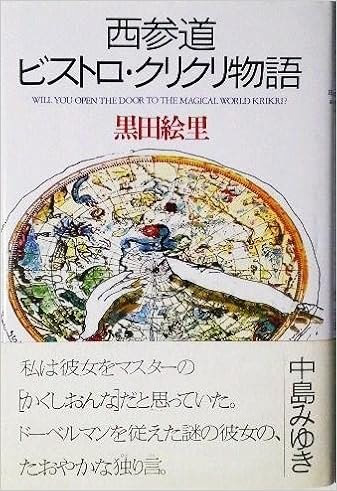こんにちは。クリエイティブ部の加倉井です。
今回は、夫婦で長年営まれている「BISTOR KRI-KRI(ビストロ クリクリ)」を紹介します。
紹介をする前に、この記事が公開される頃、今から紹介するお店は恐らく休業中です。
お店のマスターからは、紹介いただいてもお店は休業中であり、この記事を読んで来店を望まれた方に申し訳ないと、気にされておりました。
それでも、このお店には愛着があり、是非書かせてほしいという私のわがままにご了承いただきましたこと、感謝します。
日頃は夜をメインにワインと料理を出しているクリクリですが、本日の目的は日曜日にしか営業していない、とっても貴重なランチをいただくべく、いつもより大股気味にお店へ向かいます。
モノサスから参宮橋駅方面に徒歩4分。
西参道添いを明治神宮へ進むと左手側、交差点の角にそのお店は見えてきます。
黒に染められた壁に引き立つのは赤の窓枠。
窓には緑やオレンジ、黄色のステンドグラスに加えて、カラフルな牛や鶏の画が描かれ、色とりどりに染められたお店はまるで絵本の世界です。
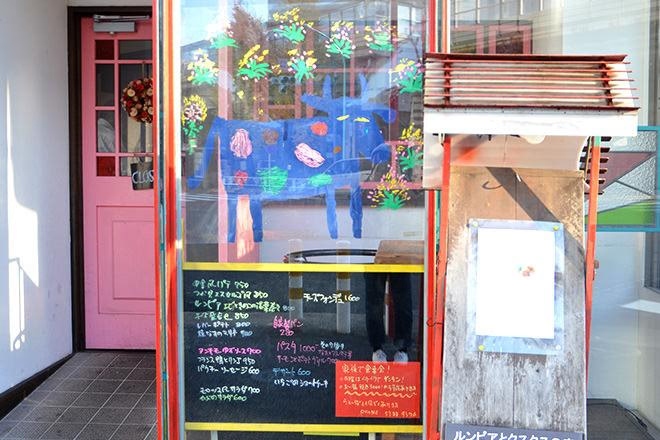
入り口でお出迎えしてくれるのは牛の画。マスターの作品。壁もご自身で塗っているとのこと。
そもそもどこかの国の料理、といったカテゴリーにくくるのが難しいお店で、地中海の雰囲気はあるものの、イタリアンともフレンチとも言いがたいものがあります。元は中近東料理店だったということもあり、その雰囲気も残ったまま、別の料理として完成された、料理までも不思議なお店なのです。
お店の前の立て看板には、本日のメニューが手書きで書かれています。
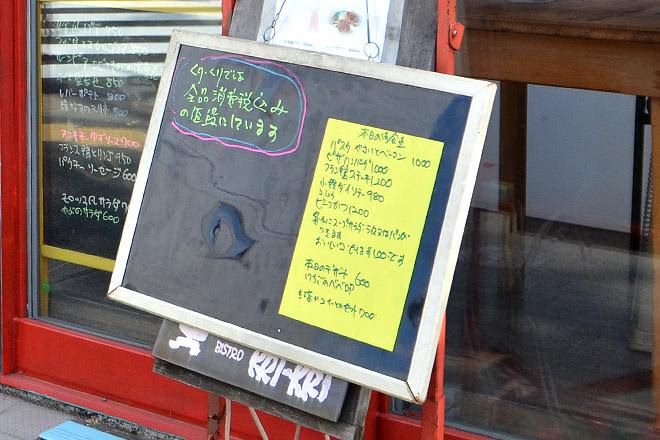
<本日の御食事>
パスタ やさいとベーコン
ピザハンバーグ
フラン鴨ステーキ
小姓ダイソテー・ビーフかつ
各自にスープ・サラダ・ライス又はパンがつきます
おいしいコーヒーは100円です
「んーーーーー。どれも食べたい。」
なんせ素材の旬な時期や、仕入れによって変わる為、固定のランチメニューはなく、時期をあけてくるたびに違うメニューが並んでいます。
ただひとつ言えるのは、どれも間違いなく美味しいということ。
悩みながらも心ときめかせてピンクの扉に手をかけました。
「いらっしゃーい」と、
温かい声と笑顔で迎えてくれるのはマスターの奥さんのエリさん。
「窓際の席でいい?」
空いているときは席を選ばせてくれるエリさんは、私が窓際が好きなことを知ってか知らずか、自然と窓際の席へエスコートしてくれます。
お店の中心にある厨房でせっせと腕を振るうのはマスターのケンさん。
創業は50年にもなり、2代目マスターです。
店内は外装とはまた違った落ちついた濃い木に包まれており、ステンドグラスのオレンジ色の光がとても綺麗に差し込んでいます。
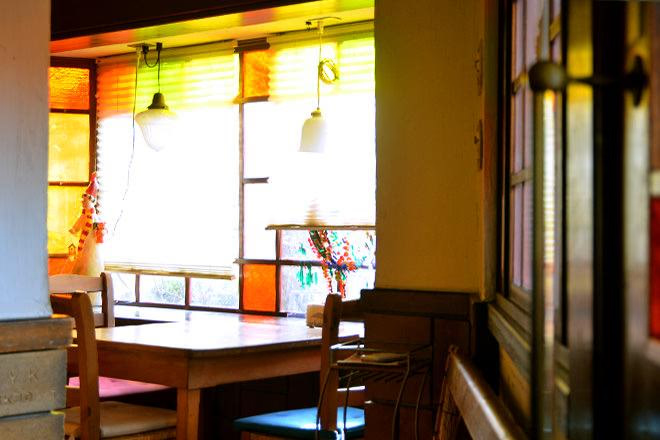
奥のステンドグラスの席。
年期の入った木製のテーブルもあれば、赤足の黒いテーブルもあり、椅子のデザインもバラバラなのに、統一された空気感。フロアの片隅には民芸調の階段箪笥がひっそりと置かれているかと思えば、カウンターの下には中近東の壷やチェスト、大きな銅皿も並べられています。
このエスニックな品々はアルプスの一角に登山するほどの山男のマスターが、シリアに立ち寄った際に自ら揃えたもの。
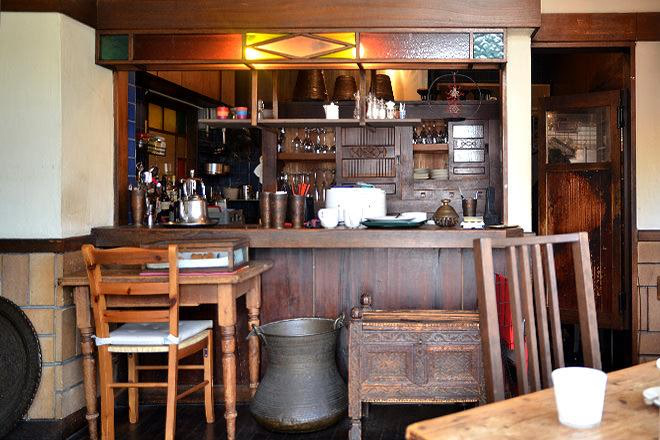
カウンターのステンドグラスのランプもたまりません。ちらほら見える雑貨も東洋から北欧、中近東などなどいろいろな国の匂いがします。
何より存在を放つのが、厨房の中に大きく構える水屋箪笥。
大正時代の年代物で、釘を一切使用していないそうです。
重厚感ある箪笥のなかに、清く正しく並べられたワイングラスに時とロマンを感じざるをえません。
料理もさることながら、内装までも全く違うカルチャーが混在し、融合させるマスターのセンスに痺れます。
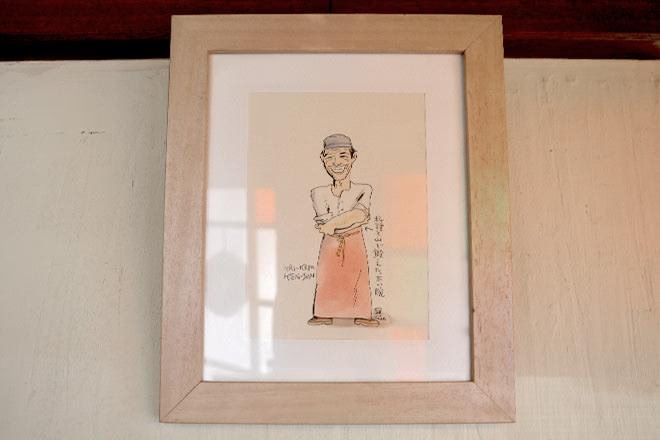
10年前のマスター。
また、入り口には、マスターの似顔絵が飾ってあります。
今と変わらぬ赤い前掛け姿は10年前に描かれたものだそう。
サイトや立て看板など、あちこちに見られるこの似顔絵は、実はものさす編集長 中庭が桑沢デザイン研究所に通っていた時代の恩師にあたる「磯田先生」が描いたものだとかで、これも素敵なご縁だなぁと思わざるをえないのです。
クリクリの常連である磯田先生は、サイトで公開されているコラムにも良く登場します。
「イソさん」の愛称で書かれる磯田先生は、イラストから受ける印象よりもパワフルな方で、エリさん自身からも磯田先生とのエピソードを止めどないほど話してくれました。
テーブルに並べられたフォークやコップひとつとっても、視線の中に見えるもの全てが、マスターとエリさんの愛情に包まれており、家具達も凛とそこに存在しているこの空間に、己も身を置いていることの嬉しさが自然とこみ上げてきます。
着席してから気持ちも身体もクリクリの世界に溶け込んだ頃に、エリさんが運んできてくれるサラダとスープ。
まず驚くのはサラダの野菜の多種多様たるや。
トマト、キュウリ、カイワレ、キャベツ、ニンジン、赤玉葱、りんご、などなど食べながらあれもこれもと探してしまいます。
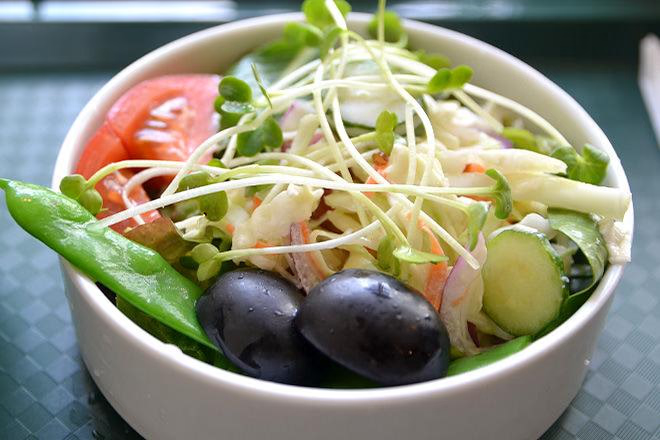
奥にはリンゴが潜んでいます。フレンチドレッシングがフルーツにも自然とぴったりなんです。
手前には切られた巨峰がふたつ。
「切られていることで美味しい皮も一緒に食べてもらえるし、種無しと一目で分かる」といったエリさんのひと工夫なんです。
ちなみにいつもサラダには巨峰が入っているわけではありません。たまたま色がとても濃くて美味しそうだからと手に取ったものをサラダに加えたそうです。
確かに甘い!それにいつも皮をむいて食べてた巨峰もエリさんの思惑通りパクりと頬張っていました。
実は提供される野菜の一部は、ご夫婦自身で育てた野菜たち。
山梨にクリクリ農園があり、茄子やトマト、純ベリーを無農薬で栽培し、お休みの日は山梨まで毎週手入れをしに、足を運び育てているとか。
「スーパーで並んでいる野菜はどれも形が綺麗でしょ。
でも、普通の農家で育てた野菜って形は揃っていないものばかりで、こーんな曲がったキュウリなんて当たり前なのにね~。だから買う時もついつい曲がったキュウリを買っちゃうんです。」
それが自然な形だからと、手をいろんな野菜の形にして説明くれました。
両手で抱えるほどの大きさのマグカップには、しめじと三つ葉のコンソメスープ。
塩分は控えめ。飲むと口いっぱいに野菜のやさしい味が広がります。
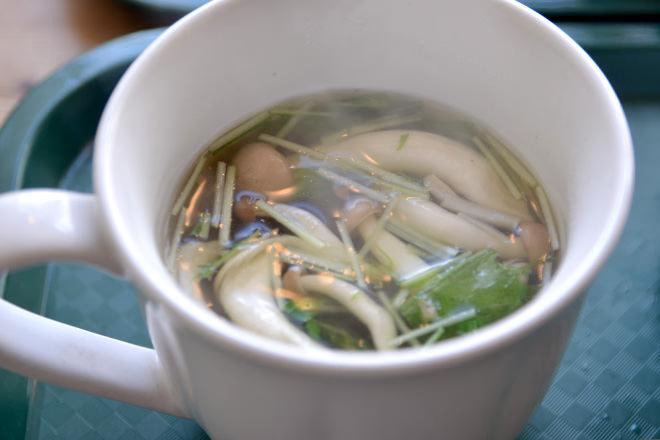
両手で抱えて飲むスープは、身体の芯と手のひらを温めてくれました。
このところ、お客様から塩や胡椒をもっと加えても良いかと聞いてくるお客様がいるそうで、エリさん曰く、「添加物とか化学調味料が沢山普及しちゃって、味に物足りなさを感じてしまっているんじゃないかと思うんですよ」とのこと。
でも、「私はカップラーメンとか好きで時々食べちゃういますけど」と、お茶目に笑って話してくれました。
そしてお待ちかねの今回のメイン。
悩んで決めたのは「フラン鴨ステーキ」に「自家製パン」です。
鴨の上には、マスターお手製のベリーソース。
鴨の独特な匂いに、このベリーの上品な酸味と甘さが癖になるんです。
ベリーソースは果肉の形が綺麗に残っているにも関わらず濃厚で、丁寧に煮詰められたことが分かります。お肉の柔らかさも絶妙で、鴨の弾力さはありながらも、決して固くはない、食べ応えのあるお肉に仕上がっています。
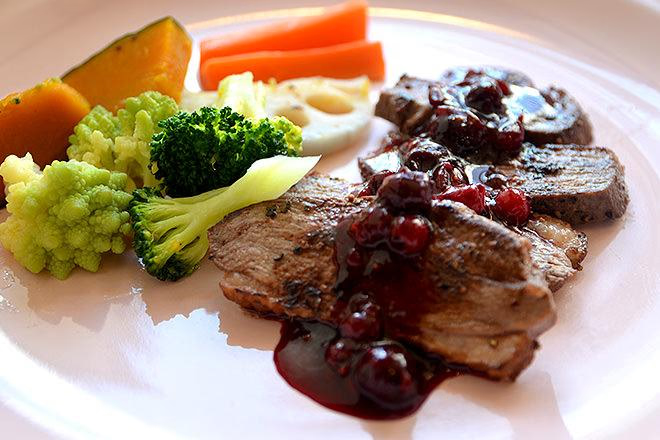
フラン鴨ステーキ。
添え物を見てお気づきの方もいるかもしれませんが、これまで出てきたサラダのニンジン以外の野菜は一切かぶっておりません。
恐るべしクリクリ...。多種多様な野菜を巧みにつかいこなし、飽きることがないんです。
自家製パンは長くから愛される定番。
皮は固めのパリッ。中はもっちり。
かすかなバターと塩の香りが、炭水化物の甘味であるブドウ糖までもをダイレクトに感じさせる逸品です。
いつも私はご飯派なので、パンを食べたことが無かったのですが、今度からクリクリではパンを注文することになりそうです。
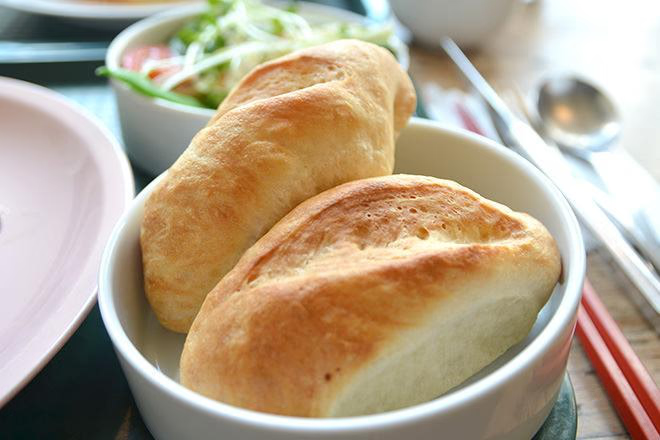
自家製パンふたつ。
「ふう〜。」と腹九分目の程よい満腹感に、肩の力を抜き、幸せなため息が溢れ、「コーヒー飲みたいなぁー。」という心の声を悟られたかのように、コーヒーが目の前にそっと差し出されます。
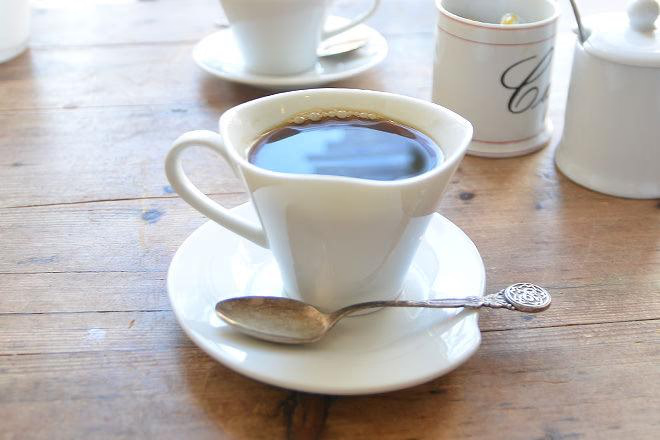
正直なところ、コーヒーの味の良し悪しについて私はあまり分からないのですが、きっとこのコーヒーを美味しいと言う人がほとんどだと思うんです。
だって料理も家具のひとつひとつを見ても、ご夫婦の愛情がギュと詰まったものばかり。
コーヒーの豆一つにも、コップに注がれる一滴にも、夫婦とお店で培った大切な時間や思いが宿っているのかもしれません。
ご夫婦の人柄もあいまってこのお店の虜になってしまいました。
しかし、冒頭でも書いたように、残念ながら2017年1月からしばらく休業されるとのこと。
期間は特に決まっておらず、3ヶ月になるのやら半年になるかも未定だそうです。
どうしてもクリクリの不思議な世界観を感じたい方は以下の本を。
------------------------------------------------------------------------
『西参道ビストロ・クリクリ物語』
(著)黒田 絵里
------------------------------------------------------------------------
挿絵も含めエリさんが執筆した本です。
そしてもし、数ヶ月後にお店の前を通り、クリクリが開店しているようであれば是非立ち寄ってみてください。
素敵な時間を過ごせるはずです。
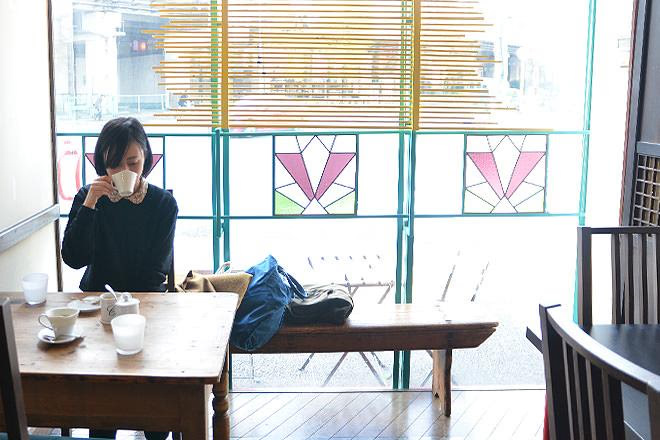
BISTOR KRI-KRI(ビストロ クリクリ)
東京都渋谷区代々木3-38-12
tel 03-5388-9376
http://www.terra.dti.ne.jp/~hayate-7/index.html

